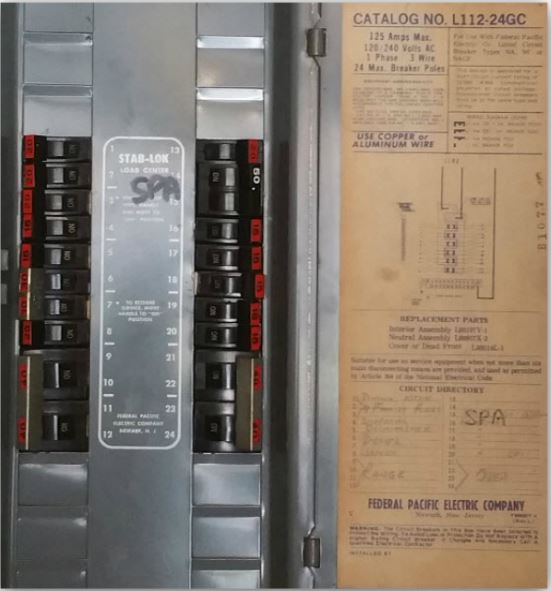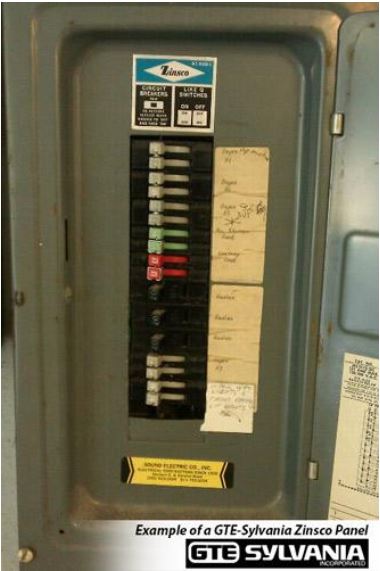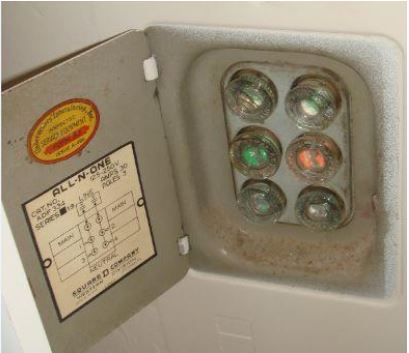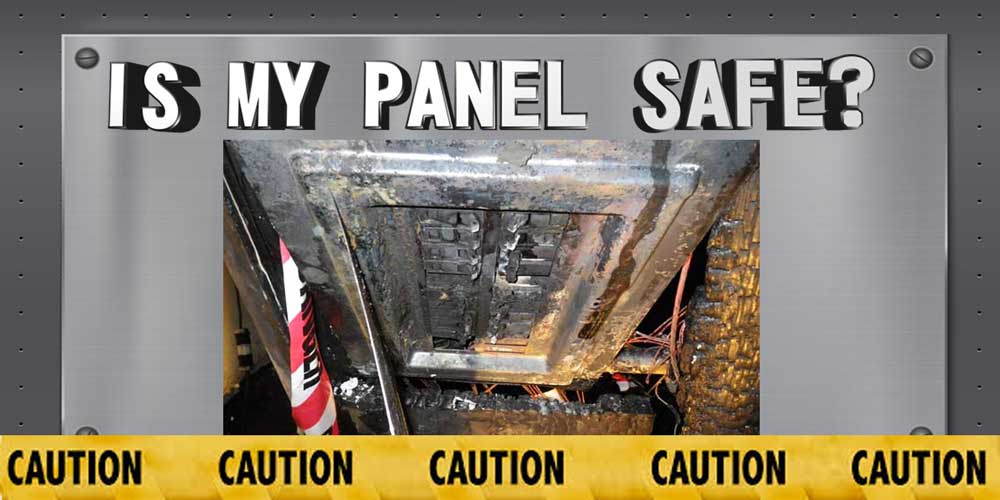SAVE 50% and ship free with holiday special Code: SAVE NOW Click here to see new 100 amp and 200 AMP sets
Electrical fires can be devastating and start without warning. Sometimes the problem is hidden for years just waiting for the right circumstances because of a bad quality breaker panel. In East Portland Oregon, two homes were destroyed just days apart. In both cases, the fires could have been prevented.
Portland Fire & Rescue investigators recommend a routine safety inspection, especially when doing repairs or remodeling. 1
What to Watch Out For
If your home was built before 1990 there’s a possible chance your breaker panel could be outdated. If you never thought to check or your breaker panel looks like something from a 1960’s Sci-Fi movie, you should do so now. Having any kind of outdated electrical device in your home, especially the main source, can be extremely unsafe.
Electrical panels contain safety devices (either fuses or circuit breakers) that trip and shut off the power when too much electricity flows through them. This helps prevent fires caused by overheating wires.
Many homes built prior to 1990 with outdated panels might not work as intended, leaving the home vulnerable to a house fire. Here are 4 types of unsafe breaker panels you should consider replacing if you have them. 2
Federal Pacific Electric (FPE) Panels
If your home was built between 1950 and 1990 and is equipped with a Federal Pacific Electric (FPE) circuit breaker panel with Stab-Lok circuit breakers, you run a significant risk of breaker malfunction and fire.
Why they’re unsafe: FPE electrical panels’ circuit breakers fail to trip when they should (when there’s a short circuit or circuit overload). This problem has lead to thousands of fires across the United States.
There are also many reports that FPE circuits in the off position still send power to the circuit. This can cause electrocution when working on a circuit you believe to be off.
How to tell if you have one: FPE panels are most common in homes built between 1950 and 1980. Federal Pacific Electric will likely be written on the cover of your breaker box. Inside, look for the name Stab-Loc (the brand name of the circuit breakers). 3
Zinsco Panels
rolex daytona rolex calibre 7750 mingzhu engine 116519 uomo white dial has set the quality standard in affordable automatic watches.high quality luxury watches on net fake for men and women.
GTE-Sylvania or Zinsco panels were popular electrical breaker panels installed in homes throughout the 1970s, over 30 years ago. Zinsco is now defunct, but many homes still have these panels.
Why they’re unsafe: The circuit breakers inside many Zinsco panels melt to the main ‘bus bar’. This means the breaker can’t ever trip, even when there’s a short or overloaded circuit. So if there ever is a short or other problem, the surge of power melts wires and starts fires in your home.
How to tell if you have one: The name Zinsco anywhere on the panel is a sure sign it should be replaced. Also, many GTE-Sylvania or Sylvania panels are simply re-branded Zinsco panels or contain the problem Zinsco design. These should also be replaced.
However, not all Sylvania and GTE-Sylvania branded panels are dangerous. If you have one, contact an electrician to have its design inspected to ensure it’s safe and up to code.
Split-bus electrical panels
A typical modern circuit breaker has a single metal bus. Electricity comes into the panel, passes through the main breaker and to the bus. The bus then connects to each individual circuit breaker, providing power to your entire home.
You can then shut off power to the bus (and therefore your entire home) simply by turning off the main breaker.
Split-bus electrical panels are different. They have 2 buses and no single main disconnect. They have up to 6 breakers labeled “main”. One of these main breakers controls power to half (the bottom) of the breakers in the panel. The other main breakers connect directly to the first bus.
Read about Breaker box labels
Above is a photo of a split bus panel with the front cover removed. You can see how the top breakers are connected directly to the incoming power (large black wires at the top). Then the 6th breaker supplies power to the lower breakers (see the wires connecting them). To be honest, when I look at this picture, I just see a nightmare of wires and complexity.
Why they’re unsafe: By themselves, split-bus panels aren’t unsafe. However, these types of panels haven’t been used for over 40 years. That puts them past their expected lifespan, meaning the circuit breakers may not trip as they are designed to.
Plus, electrical code no longer allows for multiple disconnects.
How to tell if you have one: Open the front cover of your electrical box. Are your breakers divided into 2 groups? Is there no single disconnect breaker? These are good indications that you have a split-bus panel. 4
Fuse box
They are old electrical panels that use fuses instead of circuit breakers to protect your wires from becoming overloaded. When a circuit draws too much electricity, the fuse burns out and must be replaced. I had this set-up at a home I rented a few years back, landlords were old farmers and not much into keeping things up-to-date. The house was old as well so I never questioned it either, just assumed it added a “vintage” touch to the home.
Why they’re unsafe: Fuses aren’t exactly unsafe. They work just like circuit breakers except when a fuse “blows” it must be replaced, it cannot just be reset. The same concept as a light bulb, if it goes out, it’s thrown away and replaced. However, most fuse boxes in homes today are unsafe because they’ve been modified to try to serve today’s energy demands, when in fact they just can’t.
Homeowners (and sometimes contractors) create problems in many fuse boxes that make them unsafe. Here are a few:
-
Placing too many things on a single circuit.
Because fuse boxes typically have fewer circuits, homeowners often end up plugging in too many electrical appliances to a single outlet. That leads to fuses that blow a lot, which can lead homeowners to…
-
Replacing a fuse with a bigger fuse.
If you replace a 15-amp fuse with a 20-amp fuse (or larger), your fuse may stop blowing. However, you’ll also create a massive fire hazard. The wires in that circuit are only rated for 15-amps, not 20!
-
Replacing the fuse with something metal.
Some homeowners go a step further and insert a metal object (like a penny) where the blown fuse once was. Again, this eliminates blown fuses, but also completely removes the safety that fuses provide. Your wires could pull large amounts of electricity, overheat and start a fire.
How to tell if you have one: Chances are if you have a fuse box, you already know it. But if you’re not sure, find your main electrical panel and open it up. Instead of a bunch of switches, you’ll see fuses that resemble glass drawer knobs. 5
What to do if you have any one of these panels
If you have one of these unsafe and outdated electrical breaker panels, it is recommended to replace or have them replaced. You should also have an electrician inspect the panel to see if there are any signs of problems. Once you have your breaker panel current, the next best thing to do is to make sure you know what were each circuit breaker runs electricity to. Most home breaker panels have a reference guide stickered on the inside of the door of the box, that can be handy for sure, but if the previous owner had horrible handwriting you’re caught staring at what looks like hieroglyphs. You can solve this problem by purchasing breaker labels and applying them to each breaker for easier reference.
FOOT NOTES
2. NBC


I do not even know how I ended up here but I thought this post was great I dont know who you are but definitely youre going to a famous blogger if you arent already Cheers.